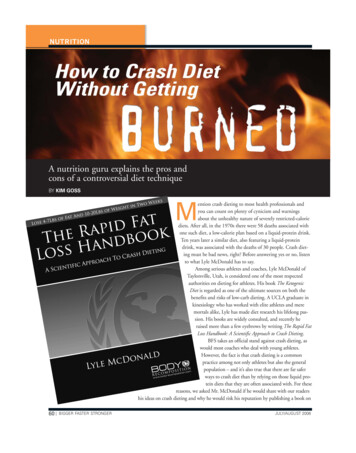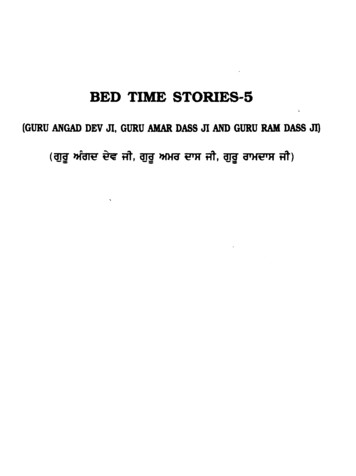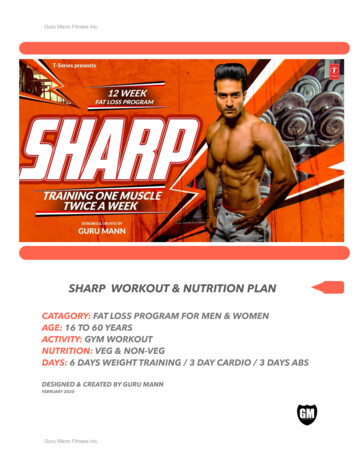
Transcription
NUTRITIONA nutrition guru explains the pros andcons of a controversial diet techniqueBY KIM GOSSention crash dieting to most health professionals andyou can count on plenty of cynicism and warningsabout the unhealthy nature of severely restricted-caloriediets. After all, in the 1970s there were 58 deaths associated withone such diet, a low-calorie plan based on a liquid-protein drink.Ten years later a similar diet, also featuring a liquid-proteindrink, was associated with the deaths of 30 people. Crash dieting must be bad news, right? Before answering yes or no, listento what Lyle McDonald has to say.Among serious athletes and coaches, Lyle McDonald ofTaylorsville, Utah, is considered one of the most respectedauthorities on dieting for athletes. His book The KetogenicDiet is regarded as one of the ultimate sources on both thebenefits and risks of low-carb dieting. A UCLA graduate inkinesiology who has worked with elite athletes and meremortals alike, Lyle has made diet research his lifelong passion. His books are widely consulted, and recently heraised more than a few eyebrows by writing The Rapid FatLoss Handbook: A Scientific Approach to Crash Dieting.BFS takes an official stand against crash dieting, aswould most coaches who deal with young athletes.However, the fact is that crash dieting is a commonpractice among not only athletes but also the generalpopulation – and it’s also true that there are far saferways to crash diet than by relying on those liquid protein diets that they are often associated with. For thesereasons, we asked Mr. McDonald if he would share with our readershis ideas on crash dieting and why he would risk his reputation by publishing a book onM60 BIGGER FASTER STRONGERJULY/AUGUST 2006
such a controversial topic. Here is what we learned:BFS: Lyle, what on earth were you thinking whenyou decided to publish a book about crash dieting?LM: Knowing what I know, I would love to seeeveryone who needs to lose weight make small ormoderate changes in their diets, but the reality is thatsome people are going to crash diet no matter whatyou tell them. It’s also a fact that there are a lot ofbad ways to crash diet, and I want to at least put away of doing it out there that is nutritionally sound,based on good science and as safe as it can be made. Isay this because crash dieting is never completely safe,but there are comparatively better ways of doing it.BFS: In what situationsmight a crash diet be appropriate?LM: Let’s say there’s awrestler who has two weeks tomake weight, and if he doesn’tmake weight all his dreams forthat national championship goright out the window. Inworking with bodybuilders,I’ve found that many of themoften get behind on theircontest preparation. Then ofcourse there are folks whosimply want to get in shapeon very short notice for spring break, a wedding or a high school reunion.Lyle McDonald coachesSarah Mawson at TheEdge Strength andConditioning Center inSalt Lake City, Utah.BFS: What about those diets that simply haveyou substitute a protein shake for a meal – isn’t thatthe simplest way to diet?LM: Simple, no doubt, and yes, I would love forpeople to take a longer-term approach, rather thantaking 12-20 weeks to lose the weight. The problemis there are situations where a moderate approachsimply won’t work.BFS: There has been a lot of bad press aboutcrash dieting. Take, for instance, the uproar over thediet in the book The Last Chance Diet after it wasassociated with the deaths of many individuals. Whatwas the problem there?LM: That is probably the most infamous crashwww.bigger fasterstronger.com1-800-628-9737 61
NUTRITIONdiet, which came out in the early 70s. It is only superficiallysimilar to what I describe in my book. The 70s diet was basedon nothing but lean protein in the form of a protein supplement that had zero bioavailability. On top of that the bookfailed to recommend vitamin-mineral supplements. As a result,several people got into problems where their bodies were burning cardiac tissue because of the totally inadequate proteinintake, and they were suffering from other deficiencies frommineral depletion. In later studies using similar types of dietsbased instead on whole foods and providing high-quality protein and vitamins and minerals, individuals experienced noneof these problems.BFS: Two popular books that deal with crash dieting areExtreme Crash Dieting by Dr. Eric Serrano and The RadicalDiet by Dr. Mauro Di Pasquale. What do you think aboutthose books?LM: They are based on similar concepts. What is unfortunate about Dr. Serrano’s diet – and by the way Dr. Serrano and Iare good friends – is that it’s very heavily supplemented. To follow his diet requires about 300 to 400 worth of supplementseach month. The diet probably works, but I don’t think it doesanything to help with long-term adherence because when someone finishes with the diet they still don’t know how to eat. Ithink it’s just as easy to use whole foods, which are cheaper andtypically taste better, than to take a lot of pills and powders. Idon’t want people trying to live on protein drinks.As for Dr. Di Pasquale’s book, that isalmost a carbon copy of hisAnabolic Diet, which was a five-day low-carb diet alternatedwith two days of carb-load, just with lower calories. He didn’treally change anything. But my biggest problem with his bookis that of the 97 pages, it’s about 20 pages of information and70 pages of supplement ads that he tells you are required tomake the diet work.BFS: Is it also true, then, that one of the advantages of premeasured meals is that you can follow the diet precisely, but thedrawback is that it doesn’t teach you how to eat properly whenthe diet it over?LM: Precisely. These meals are convenient and can be prepared quickly, but as far as helping you to keep that weight offin the long term they are less than ideal. I would rather get people into the habit of eating whole foods while they are on acrash diet so when they get off, all they have to do is add otherfoods to what they are already eating.BFS: What about the benefits of fasting, such as cleaningout toxins and giving the digestive system a rest?LM: The liver is amazing at clearing the toxins out of oursystems, and I’ve never seen any research that suggests that thedigestive system needs a rest.BFS: The subtitle of your book is How to Lose 4-7 Poundsof Fat and 10-20 Pounds of Weight in Two Weeks. Why do youemphasize the distinction between fat and weight?LM: A significant part of the weight loss in a low-carbohydrate diet tends to be from water. This was one of the reasonsfor the popularity of the Atkins Diet, because it was verymotivating to watch the scale drop by seven pounds in thefirst two or three days. But what you have to realize with thatdiet is that people are primarily experiencing water loss, notfat loss – it's not fat loss yet. And it's doubly important torealize that if the Atkins dieters eat carbohydrates again thewater weight tends to come back just as quickly, whichcan be very demoralizing. In my book, right up front, Iwanted to make certain that the reader is not being misled into believing that losing 20 pounds in two weeks isthe same as losing 20 pounds of fat tissue.BFS: What kind of results can a person realistically expect on your diet?LM: The results have been about what’s promised in that subtitle. I get e-mails that some peopleare dropping 10-20 pounds of weight in two weeks,and losing about 4-7 pounds of bodyfat. Some larger individuals have used it for extended periods and have lost tremendous62 BIGGER FASTER STRONGERJULY/AUGUST 2006
amounts of weight, 150 poundsand more, whereas lighter femalestend not to lose as much.However, lighter females tend notto lose that much on anyapproach simply because theirrequirements for maintenancecalories are so much lower. Evenleaner individuals have reportedno loss of muscle mass, no loss ofstrength, no loss of performance –as long as they did it exactly theway I set it up in the book.BFS: We often hear trainersand people in medical fields saying if you go on a diet, youshould never lose more than twopounds a week. Where did thatidea come from?LM: That’s a really good question, and I don’t have an answerabout its source. When they’vedone research looking at the typeof diet I’m recommending, usuallyinvolving very obese individuals,fat losses of 4-7 pounds a week arenot uncommon.If you diet smartly, you don’t have to losemuscle while losing fat.Four years ago NFL veteran Ethan Brooksdropped 6.7 percent bodyfat in six weekswhile gaining strength and building muscle. Ethan’s story was featured in ourSpring 2003 issue.BFS: When you look at topcompetitive bodybuilders youworked with, are such ultra-leanathletes following the types ofguidelines for crash dieting you’rerecommending?LM: Probably not to quitethat degree. The typical naturalbodybuilder may start dieting atabout 10-12 percent bodyfat, butthey may start 16 weeks out fromtheir contest. If they know whatthey are doing, they will give themselves a very long time to getinto shape, because their goal is to lose as much fat as possiblewithout losing any muscle so they can look their best on stage.Typically what they’ll do is start with a diet that is moderatelycalorie-deficient while they weight train intensively, and as theyget leaner they’ll start to eliminate more foods.www.bigger fasterstronger.comBFS: When you pick up fitness magazines, you read aboutcelebrities who have “discovered”a new way to lose weight quickly.Do you think it’s a big problemin the United States for people tofollow what celebrities are doing?LM: Yes, because celebritiesare in a situation where if a producer tells a celebrity you have tolose 15 pounds or we are notgoing to pay you 10 million dollars to do this movie, the celebrityis going to get into shape. If average people had ten million dollarson the line, they could do it too.Celebrities also have the ability tohire personal trainers, cooks andother facilitators that the averageperson cannot afford. TheAmerican public is getting a littlebit misled in that they are tryingto get the same results as celebrities without having the same support network.BFS: Do you have any formulas to determine specificcaloric intakes on your program?LM: Typically I recommend10-12 calories per pound as astarting point, so if you weigh 150pounds you should have 1,5001,800 calories. I find that usuallyworks pretty well for most people.But on this diet, rather than starting from calories and workingbackwards, I find it works well tostart from protein and let thecalories fall where they may.BFS: How does that work?LM: The way I set it up is that people have to determinetheir bodyfat percentage and their activity level, and thisdetermines how much protein they’re going to need perday. Since the diet is primarily all protein, that is going to settheir calorie level.1-800-628-9737 63
BFS: Are you concerned that some people who hearabout your diet will simply just eat protein and think that’sall there is to know?LM: It never is that simple: Being haphazard about nutrition is asking fortrouble. For this type of diet theChris Trim, Action Photographyinformation in the book is essential. There’s a lot of information in there about what isnecessary to eat, whatprotein sources are best,what vegetables areallowed, along withadvice about getting essential fatty acids.Bruce Klemens photoNUTRITIONBFS: But you wouldn’trecommend going on this dietfor months at a time?LM: In general, no, butthere are some exceptions. Theway I have it set up, the fatteryou are, the longer you can stayon essentially any diet. Lean individualsmay only want to stay on it for twoweeks at a time, because any longer thanthat they will get into performance lossand muscle loss. For these reasons, thelast four chapters of my book detailhow to move from the rapid fat lossdiet to either a more moderate ormaintenance diet.BFS: Are most of the meals basically the same?LM: Yes, pretty much every mealis going to contain a lean protein source,such as chicken or tuna, and some sort offibrous vegetable source. You should also havesome source of essential fatty acids, such as fish oil,and a multi-vitamin/mineral supplement.BFS: Why do you recommend a multi-vitamin/mineral?LM: Even though we are trying to ensure you get all theessential nutrients with this type of diet, as the calories godown it becomes more difficult to get all your vitamins andminerals. Also, low-carb diets tend to cause the excretion ofminerals such as calcium, magnesium and potassium.64 BIGGER FASTER STRONGERChampionweightlifterssuch as HeatherSnethen mustcarefully monitortheir bodyfatto ensuremaximumperformance.BFS: Would people on this diet have to take dosages ofvitamins that are much higher than usual?LM: Not really, because this diet consists of whole foods.This type of supplement certainly wouldn’t hurt, and willabsolutely cover any potential nutritional deficiencies.BFS: What type of exercise is better when using this typeof diet: weight training or aerobic exercise?LM: Weight training, definitely, as it will help maintainmuscle mass much more effectively than aerobic training.BFS: A lot of people have a hard time starting a dietbecause it can be overwhelming to commit to doing somethingfor such a long period, say, six months or more. Would you saythat this is an advantage of your diet?LM: Absolutely. In fact, I believe one of the biggest advantages of my diet is that it gets you motivated. There is researchto show that initial quick weight loss seems to help with moving into a longer-term approach. In my book I suggest that youmight use the diet for two weeks to take off some fat quickly toget things moving, then move into a more moderate, traditional diet. The crash diet is not supposed to be maintained for thelong term. It is a short-term solution for when people have tolose weight quickly.JULY/AUGUST 2006
WINNING NUTRITIONBFS is proud to endorse and provide the full line of Pharmanex nutritional products. Pharmanex productsare used by athletes at all levels, from grade school athletes to Olympians. In the interest of helping athletes achieve physical superiority and enjoy optimal health, BFS recommends you start with the followingPharmanex products: QQQQ G3 Superfruit JuiceDerived from carefully selected“Super Fruits”Provides strong vascular and cellularprotectionHigh in antioxidantsDelicious! QQQQ QQQ LifePakThe world’s most complete and effectivenutritional productHigh in vitamins, minerals andantioxidantsConvenient, pre-sorted packages QQQQQQ Q QQQ QQQQQ G3 SuperfruitJuice PouchesSame superior nutrition as G3Superfruit JuiceConvenient, spill-resistant pouchesEach pouch provides two daily servingsDelicious!XOI BarSuperior energy bar with G3 Superfruit Juice A food-based product with nuts, fruits and whole grainsLow-glycemic carbohydrates to provide sustained energyHigh in vitamins, minerals and antioxidantsConvenient, individually-wrapped bars for maximum freshnessDelicious! LifePak WomenScientifically formulated to fulfill thespecial needs of womenHelps prevent osteoporosisHigh in vitamins, minerals andantioxidantsConvenient, pre-sorted packages QQQ LifePak TeenSpecifically designed to fulfill the specialneeds of children 9 to 18Protects and nourishes growing bodiesHigh in vitamins, minerals andantioxidantsMarine OmegaProvides essential omega-3 fatty acidsRich in EPA and DHA for optimal healthPromotes normal heart and brain function,immune and joint healthPromotes healthy skin and natural antiinflammatory responseFree of harmful toxins, contaminants and heavy metals1-800-628-9737Fax (801) 975-1159biggerfasterstronger.comTo order these cutting edge nutritional products, and for advice on 843 West 2400 Southhow to improve your dietary habits for optimal health and athletic Salt Lake City, UT 84119performance, check out our website.info@bfsmail.com
Create personalized, sport-specificworkouts using the most successful Set-RepComputer Software Program ever created.Beat the Computer Pro Here’s howit worksHere’s what you get12Enterathlete’s liftsinto thecomputerAthletes fill out a form listingcurrent core & auxiliary lifts.312Print Test SheetsForms for weights and field testingGenerate Individual WorkoutsComputer-aided workouts for maximum resultsEnter the lifts into thecomputer, which calculatesthe precise weights for eachset and creates individual,sport-specific workouts.3At the beginning of eachweek simply print out theathlete’s BFS Set-RepProgram weekly workoutschedule.ADDITIONAL REPORTS:Produce Top 10 ListsChallenge your athletes to improveonlyADDITIONAL REPORTS:Ironman & Power RankingsCompare to national standards 299Want to get started now?Download your FREE 30 Day Trial atwww.biggerfasterstronger.com!Each program is customized with the school name and CANNOT BE RETURNED. Please get the demo version if you are unsure of yourpurchase. Demos are available via download from biggerfasterstronger.com or call BFS. System Requirements: Pentium 133 or better,8 megs of RAM, Windows 95/98, ME or XP, 10 megs of disk space, CD-Rom drive.#325091Work smarter,not longer!
NUTRITION 62 BIGGER FASTER STRONGER JULY/AUGUST 2006 diet, which came out in the early 70s. It is only superficially similar to what I describe in my book. The 70s diet was based on nothing but lean protein in the form of a protein supple-ment that had zero bioavailability. On top of that the book failed to recommend vitamin-mineral supplements.











